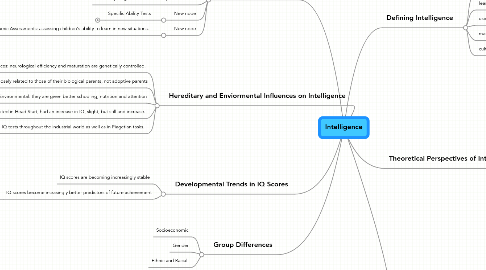
1. Measuring Intelligence
1.1. Binet: to identify people with specail needs, to show why some are making progress while others are not.
1.2. Wechsler: given to children and adolescents. A verbal and performance to get over all IQ
1.3. Stanford-Binet: used with people 2 through adulthood. Yeilds overall IQ as well as verbal and nonverbal
1.3.1. More specifically: fluid reasoning, knowledge, working memory, visual-spatial processing and quantitative reasoning.
1.4. Not everything can be summed up in an IQ test.
1.5. New node
1.5.1. Specific Ability Tests
1.5.1.1. New node
1.6. New node
1.6.1. Dynamic Assessments: assessing children's ability to learn in new situations.
1.6.1.1. assessment of learning potential
2. Hereditary and Enviormental Influences on Intelligence
2.1. Hereditary Influences: neurological efficiency and maturation are genetically controlled.
2.2. Adoption Studies: IQs are more closely related to those of their biological parents, not adoptive parents
2.3. Environmental: they are given better schooling, nutrition and attention
2.4. Early intervention: students taht participated in Head Start, had an increase in IQ, slight, but still and increase.
2.5. Flynn Effect: slow, steady increas in people's average performance on IQ tests throughout the industrial world as well as in Piagetian tasks.
3. Developmental Trends in IQ Scores
3.1. IQ scores are becoming increasingly stable
3.2. IQ scores become incrasingly better predictors of future achievement
3.2.1. Two things to remember about intelligence test scores and achievement: just because they have a high IQ, their high achievment may have nothing to do with their intelligence. 2nd; the relationship between IQ scores and achievement is not perfect, there are many excpetions to the rule.
4. Group Differences
4.1. Socioeconomic
4.2. Gender
4.3. Ethnic and Racial
5. Critique of Current Perspectives on Intelligence
5.1. Research has relied too much on traditional intelligence tests
5.2. IQ scores are too often interpreted out of context
5.2.1. a whole picture should be looked at, not just one measure or tool
5.3. Assesment of intelligence focuses almost exclusively on skills that are valued by mainstream Western culture
5.4. Intelligence tests overlook dispostions ad metacognitive strategies as important contributors to intellectual functioning
5.5. Many theorists have placed higher priority on assessing current intelligence than on developing future intelligence.
6. Defining Intelligence
6.1. adaptive, can be used to respond to variety of situations and problems
6.2. learning ability, the rate in which we aquire new things
6.3. use of prior knowledge, helps to understand and analyze
6.4. many different metal processes
6.5. culture specific, what may be in one culture, may not be in another
7. Theoretical Perspectives of Intelligence
7.1. Spearman's g: intelligence is made up of two factors, general and specific.
7.2. Cattelll's fluid and Crystallized Intelligence: two distinctly different components, fluid and crystallized.
7.2.1. fluid: aquire knowledge quickly and adapt to new situations
7.2.2. crystallized: knowledge they have accumulated from experiences and education
7.3. Gardners's Multiple Intelligence: people have several specific abilities, independant of one another
7.3.1. linguistic
7.3.2. logical-mathematical
7.3.3. spatial
7.3.4. musical
7.3.5. bodily-kinesthetic
7.3.6. interpersonal
7.3.7. intrapersonal
7.4. Sternber's Triarchic Theory: intelligent behavior involves an interpay of three factors.
7.4.1. environmental
7.4.2. prior experiences
7.4.3. cognitive process
